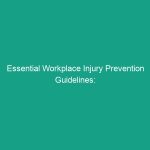Introduction
Good morning team! Today, we’re diving into an essential topic that affects all of us in our daily operations: Essential Safety Tips for Walking and Working Surfaces. Understanding how to navigate our work Environment safely is crucial to minimizing risks and ensuring a healthy workplace for everyone.
Every day, we walk on various surfaces, be it in our production areas, warehouses, or office spaces. It’s easy to overlook the potential dangers lurking beneath our feet. By being proactive about Safety, we can prevent accidents and injuries. So, let’s explore why this topic is vital for our well-being and productivity.
Understanding Essential Safety Tips for Walking and Working Surfaces
When we talk about walking and working surfaces, we refer to any area where employees walk, stand, or perform tasks. This includes floors, sidewalks, stairways, and any elevated platforms. Safety on these surfaces is crucial because slips, trips, and falls are among the leading causes of workplace injuries.
Many employees might think that accidents are rare or that they won’t happen to them. However, the reality is that these incidents can happen to anyone, often when least expected. A small spill or uneven surface can lead to serious injuries if not addressed promptly.
Key Hazards, Risks, and Safety Considerations
Understanding the key Hazards associated with walking and working surfaces is the first step toward fostering a safer workplace. Here are some common risks:
- Slippery Surfaces: Water, oil, or other liquids can make surfaces extremely slippery.
- Uneven Flooring: Cracks or gaps in flooring can create trip hazards.
- Obstructions: Tools, equipment, or materials left in pathways can lead to accidents.
- Poor Lighting: Insufficient lighting can hinder visibility, making it harder to see potential hazards.
Ignoring these risks can have real-world consequences, including injuries that may lead to time off work, decreased morale, and increased insurance costs for the company. It’s imperative that we all understand and address these hazards effectively.
Best Practices, Procedures, & Actionable Advice
Now that we’re aware of the hazards, let’s discuss some Best Practices to ensure safety on walking and working surfaces:
1. Keep Surfaces Clean and Dry
Regularly clean surfaces to remove spills, debris, and other obstacles. If you notice a spill, report it immediately and use appropriate cleaning methods.
2. Ensure Proper Lighting
Make sure all areas are well-lit. If you identify a dark area, suggest installing additional lighting or using portable lights to enhance visibility.
3. Maintain Clear Pathways
Always keep pathways clear of obstructions. If you see tools or materials left in a walkway, take a moment to put them away properly. This small act can prevent significant accidents.
4. Use Non-Slip Mats
In areas prone to spills, consider using non-slip mats. These can provide extra traction and minimize the chances of slipping.
5. Wear Appropriate Footwear
Invest in good quality, slip-resistant footwear. This is particularly important in environments where spills and wet conditions are common.
6. Report Hazards Immediately
If you encounter a hazard, report it to your supervisor. Timely reporting allows for quick action to be taken and prevents accidents before they occur.
Real-Life Example
Consider the case of a warehouse worker who slipped on a wet floor that hadn’t been marked with a warning sign. The result was a sprained ankle and several days off work. This incident could have been prevented with proper Maintenance and communication.
Regulations, Standards, and Compliance
It’s essential to understand the Regulations and Standards that govern Workplace Safety. The Occupational Safety and Health Administration (OSHA) provides guidelines that help maintain safe walking and working surfaces. These standards include:
- Ensuring that all walking surfaces are designed and maintained to minimize slipping and tripping hazards.
- Regular inspections and maintenance of surfaces to ensure safety compliance.
- Providing employees with appropriate Training on recognizing and mitigating hazards.
Compliance with these regulations not only protects employees but also mitigates legal risks and financial liabilities for the company. Creating a culture that prioritizes safety Benefits everyone.
Employee Engagement & Discussion
Now, let’s engage in a discussion! What safety challenges have you encountered related to walking and working surfaces? Have any of you had experiences where a quick action could have prevented an accident?
Feel free to share your thoughts and experiences. Your input is invaluable in creating a safer work environment for everyone!
Conclusion & Key Takeaways
In conclusion, the safety of walking and working surfaces is a critical component of Workplace Health and safety. By understanding the hazards, implementing Best Practices, and complying with regulations, we can significantly reduce the risk of accidents.
Remember, safety is a shared responsibility. Your awareness and proactive actions can make a difference. Thank you for your commitment to maintaining a safe and productive workplace. Let’s continue to prioritize safety every day!


